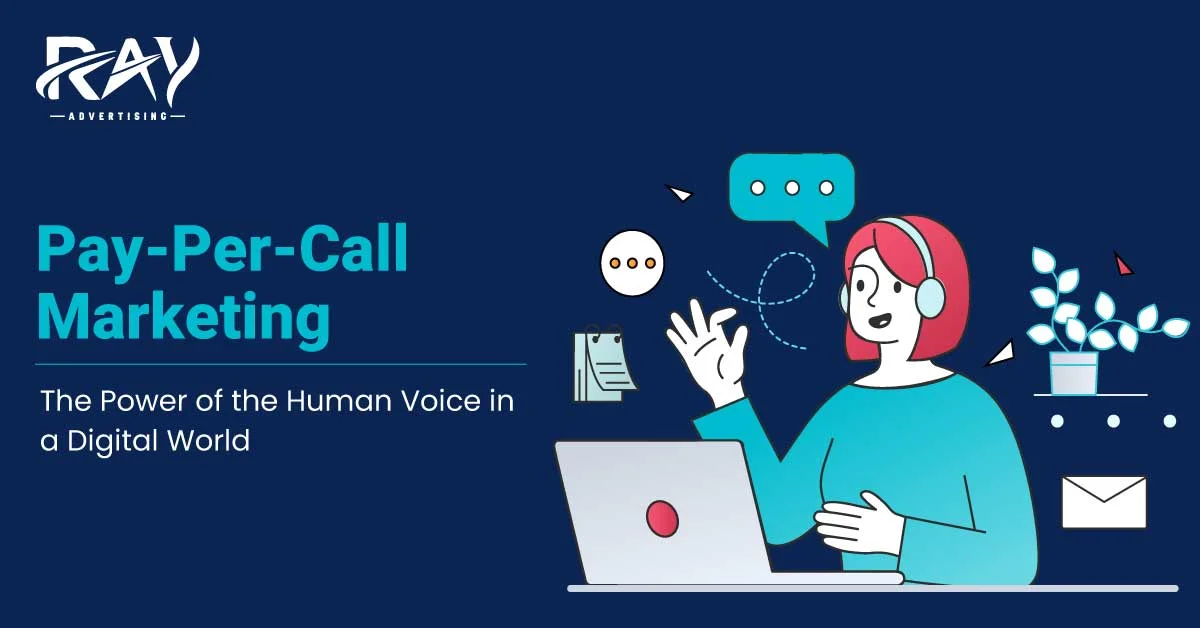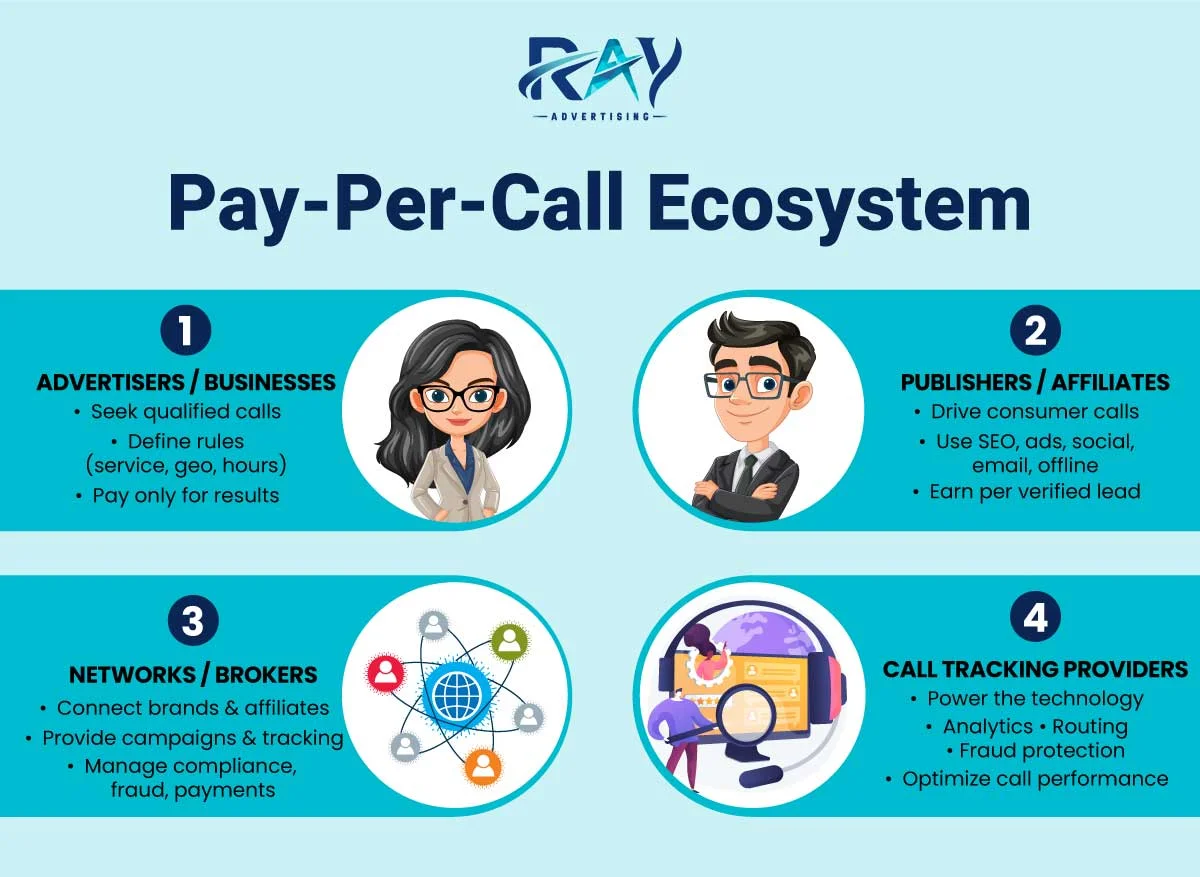



To bring marketing methods closer to humans, direct calls have no other alternative. Consumers also feel more comfortable making instant calls rather than going through the formal process of interacting. Mobile phones are not always suitable for extended browsing; instead, making a phone call is more convenient nowadays. Being dominant in market trends, Pay-per-call has become the fastest-growing category of performance marketing. The U.S. pay‑per‑call market is now projected to exceed $12 billion by 2025, making it one of the fastest‑growing channels in performance marketing.
Pay per call (PPC) is a popular advertising model of performance marketing, where businesses usually pay for inbound phone calls made by consumers who are ready to buy their products or services.
Home Services, insurance, Legal, Financial, Healthcare, Automotive, or any High-Consideration service-based verticals with an average order value north of $400 are suitable for the pay-per-call marketing model.
This is not like pay-per-click, where payment is triggered by a mere click on an ad. This is tied to voice calls that must be qualified with some conditional criteria and result in a life conversion. A call is payable only if it meets the advertiser’s rules—like minimum duration, location, time, uniqueness, and intent.
Here are the common criteria that a call must have:
Pay-Per-Call marketing is a truly powerful strategy for businesses looking to connect with customers in a meaningful way. The unique power of a direct conversation in Pay-Per-Call (PPC) marketing proved to be an exceptionally effective and profitable avenue for businesses and affiliates alike.
There are now 5.81 billion unique mobile users worldwide, up roughly 1.8% year‑over‑year, an increase of about 103 million users in the past 12 months. The exponential growth in mobile device usage and the demand for personalized experiences from the customer's end are the main fundamental reasons behind the affluence of pay-per-call marketing. Mobile search has surpassed desktop search, establishing mobile marketing as the primary internet advertising medium.
Imagine a customer so interested in your product or service that they pick up the phone. That's the magic of Pay-Per-Call is that the callers represent the highest intent of any consumer action. Performance marketing tactics turn the average Return on Ad Spend (ROAS) of 12:1. This translates into an extraordinary Return on Investment (ROI) for advertisers.
Beyond the high intent, Pay-Per-Call marketing is a financially savvy choice. It's a key part of inbound marketing, which generally costs less and provides a higher Return on Investment (ROI) than traditional methods.
For example, in pest control businesses, every $1 spent on pay-per-call advertising can yield $3 in return, achieving a 3:1 ROAS and a 60% conversion rate.
Sources: Protocol80
Source: WebFX

Pay-Per-Call marketing is a well-organized ecosystem where different players or parties work together to connect customers with the services they need.
At the core of the ecosystem are the advertisers or businesses – the companies that need customers or leads for their products or services to sell. These can be local dentists, large insurance providers, or even home solar power system installers – essentially, any business where a purchase might involve a phone call.
These businesses have some conditions that must be fulfilled, as the call or lead must be qualified for what they pay. They set their campaign parameters or rules, such as service categories, geographic areas, and business hours.
Next come the publishers or affiliates, the savvy marketers who advertise the advertiser’s offer. They conduct the marketing of businesses and generate inbound phone calls from interested consumers through various traffic sources. When a customer connects or dials through their generated number, the publishers get commission for each verified lead call from the advertiser.
These affiliates or publishers can run various methods of online and offline marketing, like SEO, paid ads, social media, email marketing, and even offline methods such as print, radio, and TV advertising, to find people actively looking for a product or service. In this way, they can achieve significant profit margins.
Here comes the most crucial role of the ecosystem that Affiliate or Pay per call network companies or brokers play by connecting/linking the two major poles, advertisers and publishers. Examples of these vital players include Ray Advertising, Marketcall, Service Direct, Lead Smart, Astoria Company, Aragon Advertising, Palo, and Digital Market Media.
Call Tracking Providers like Ringba, Phonexa, Invoca, Retreaver, CallRail, etc. are pure tech companies, offering the essential technology to monitor, analyze, and attribute inbound calls to provide lead quality and optimize campaigns for the business.
Both advertisers and publishers get access to call-tracking technologies, but through the affiliate network’s platform. If they wanted, advertisers could also go directly to providers like Invoca or Ringba and buy the tech themselves, but most prefer using a network like Ray because it handles:
A pay-per-call campaign is designed to bring businesses high-intent leads, people who are genuinely ready to engage and, often, ready to buy. Let's trace the path a call takes, from its very beginning to a successful connection.
Step 1: Advertiser Creates a Campaign
Step 2: Network Promotes Campaign to Publishers
Step 3: Publishers Apply & Receive Unique Tracking Numbers
Step 4: Publishers Generate Inbound Calls
Step 5: Customer Calls the Tracking Number
Step 6: Call is Tracked & Attributed
Step 7: Qualified Calls are Routed to Advertisers
Step 8: Publisher Receives Commission
In Pay-Per-Call marketing, technological tools have a very important influence. Other than the key players I have discussed, some incredible technology is working tirelessly behind the scenes, making sure every conversation counts. It maintains the nervous system of the entire operation, keeping everything connected, informed, and running smoothly. Without these tools, we'd be lost in confusion and miss opportunities with lower quality. Let's peel back the curtain and see what makes it all tick.
Call routing tools like Ringba, Invoke, etc., provide a smooth customer experience and improve conversion rates. They get a call to the right person or place. Ensuring every customer lands exactly where they need to be.
Here's where the magic of artificial intelligence steps in, transforming raw call data into genuine understanding. These tools are like having an assistant who listens to every conversation and gives you the highlights, helping you learn and improve.
Call Recording & Transcription: Recording calls allows you to analyze conversations for quality assurance. AI automated transcriptions let you quickly review discussions, identify trends, and verify the quality of leads generated by partners. This data is also vital for agent training and ensuring compliance.
AI Call Summaries: AI call summaries automate the transcription process and then generate brief, objective summaries. You can instantly see if that sale was confirmed or an appointment booked, no sifting through hours of audio required..
Lead Scoring: Lead scoring software can give you a clear picture of how valuable each call truly is. It helps your team focus on the most promising leads.
Predictive Analytics: By analyzing past call data, these tools forecast future results. Use these insights to really dial in your campaigns, focusing effort and money exactly where it'll pay off.
Algorithm Training: With this very clever application, you can actually share your high-quality lead data, like call duration, keywords used, and the source of the call, with your ad platforms. This valuable information will enrich the algorithm, and by doing so, you can train it to find more people just like your best customers for even better results.
IVR is your super-smart automated receptionist. It's the voice that greets you when you call a large company, guiding you to the right department without human intervention.
When someone calls from an ad campaign,n that means they are quite interested in the product or services; otherwise, they never took the effort. A direct voice call is far more humanistic than filling up a form, sending a message, or replying to an email. This direct conversation is powerful because it allows for personalized guidance, making customers feel heard and understood. That is the magic of the Pay Per Call marketing technique.
It's no secret that we live in a mobile-first world, and the constantly evolving technology behind pay-per-call makes it incredibly powerful. So, if you're an affiliate or an advertiser seeking high-quality leads, it’s high time to build strategic partnerships with reputable affiliate networks that align with your goals.